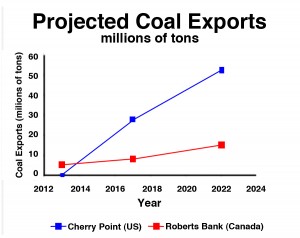— from Barbara Bentley —
Don’t be placated by BNSF assertion that they can “control” coal dust from open-car trains bringing coal from Wyoming to Bellingham (cited on Orcas Issues in a recent extract of a longer article by Floyd McKay).
 Well, they may be able to reduce the “escape” of coal dust by 85%, but Peabody Coal is planning to export 53 million tons of coal per year through the Cherry Point. And, as you can see in the graph, the amount of coal being delivered is going to go up — and go up much faster at Cherry Point than at North America’s current largest coal terminal at Canada’s Roberts Bank. It looks to me like that’s still a lot of dust.
Well, they may be able to reduce the “escape” of coal dust by 85%, but Peabody Coal is planning to export 53 million tons of coal per year through the Cherry Point. And, as you can see in the graph, the amount of coal being delivered is going to go up — and go up much faster at Cherry Point than at North America’s current largest coal terminal at Canada’s Roberts Bank. It looks to me like that’s still a lot of dust.
Nerd alert
Let’s do the math. The plan for the coal export terminal at Cherry Point estimates that 8 to 12 trains, made up of 100 to 125 cars will unload coal each day. In BNSF’s own study in 2010 on dust suppressants, they found that dust “escape” could be reduced by 73% to 93% depending on the brand of suppressant tested. (These “topical treatments” are sprayed on the top of a load in a car; “body treatments” had no effect.) From these data, we can create a best-case, worst-case, and something-in-the-middle-case scenarios.
........................Best Case .....Something in the Middle.....Worst Case Trains Per Day..............8....................10....................12 Coal Cars Per Train.......100...................115...................125 Dust Lost Per Car (lbs)...500...................800..................2000
Now we can calculate the amount of dust “escaping” from the coal transport per year under each of the scenarios.
........................Best Case .....Something in the Middle.....Worst Case Dust Lost Per Year (tons) w/suppressant.....5,110..................25,185.............147,825
Even in the “best” case scenario, open-car coal trains would deposit more than five thousand tons of coal dust during their journeys across Washington. And, while I hope that we never see the worst-case scenario, even the something-in-the-middle is an astonishing twenty five thousand tons (yes, tons!) of coal dust “escaping” into the environment. God forbid if greed overcomes social responsibility and we have to face the worst case scenario.
That’s not the end.
Unfortunately, the train cars are not the end of the road. Each of those train cars must dump their loads at the docks where the coal is transferred to the bulk-carrier ships. Now the “topping agent” is no longer on top, so dust will again become airborne as the coal is moved from train cars to storage piles, from storage piles to conveyors, from conveyors to the ship’s hold. And this dust is not spread along a thousand mile journey from Wyoming to Bellingham, but is “escaping” at a point source on the shore of the Salish Sea. Depending on the dust suppressant plans for the terminal, those twenty five thousand tons of dust could blanket the San Juans.
As magical as Orcas Island is, I don’t want even a ton of pixie dust blanketing us. Can you imagine what twenty five thousand tons of coal dust would be like?
**If you are reading theOrcasonian for free, thank your fellow islanders. If you would like to support theOrcasonian CLICK HERE to set your modestly-priced, voluntary subscription. Otherwise, no worries; we’re happy to share with you.**








You have conveniently calculated the total amount of dust that may be lost between Wyoming and Bellingham and concluded that it will all fall off the train in WA. And to add insult to erroneous math you suggest (horror) that “those twenty five thousand tons of dust could blanket the San Juans.” Uh-huh. Of course you would have to make the trains fly and then circle the county while dive bombing sensitive ecological sites.
Have you ever walked the rail lines in Montana where the coal trains have been running daily for decades? Probably not. I have (while hunting each year) and contrary to popular delusion they aren’t buried in tons of (organic) coal dust. In fact I haven’t seen any coal dust at all, and these are the main tracks that several coal trains travel every day. Sorry to add a little reality to the discussion, but I’m tired of all the bogus scare tactics being thrown around about this issue.
John – Please note that I did differentiate between the dust along the route and the potential of dust AT THE TERMINAL. Read “And that’s not the end” paragraph again. Also, the dust is carried by the wind, and in the water around the San Juans. No need for flying trains.
“In fact I haven’t seen any coal dust at all, and these are the main tracks that several coal trains travel every day. Sorry to add a little reality to the discussion, but I’m tired of all the bogus scare tactics being thrown around about this issue.”….. quote John Davidson.
You might not have seen coal dust but I can guarantee you that it is still around; swept up by wind and deposited by rain and carried to ground by snow and distributed down stream by creeks, streams and rivers.
Your use of the word “organic” to describe coal dust does not compute in my mind anyway. Using your definition, oil, uranium and asbestos are “organic”. “Scare tactics” indeed.
Barbara- “Even in the “best” case scenario, open-car coal trains would deposit more than five thousand tons of coal dust during their journeys across Washington.” Unless the figures you provided are only for the miles traveled in WA, you have forgotten that the trains will originate in WY and travel through MT and ID.
Steven- You can guarantee that it’s still around even though these tracks have been used daily for decades by coal trains and there is NO visible evidence? I think you’re missing the point; if this dust could “blanket” the San Juans don’t you think that there would be at least a teensy, weensy, little bit along the tracks if the dust billows out of every car and destroys life as we know it for miles around (OK, that’s a bit of an exaggeration of the claims being made). I’m just saying that from actual observation that I haven’t been able to see any evidence of coal dust, or ecological damage through some of the most scenic areas of MT. Oh, and your comparison of inert coal dust to oil, uranium, and asbestos is, well, ridiculous. If you don’t recognize that “scare tactics” are being used by those opposed to the coal trains/terminal then you have a very, very closed mind.
Thank you Barbara for your letter and the time taken to reflect deeply and make calculations. We need to worry about coal dust – a little can cause a lot of damage – ask any W. Virginia coal miner.
The larger conversation around coal transport must continue to include the fact that governmental practice of leasing the Federal land where the mining is taking place is at an unrealistically low price – giving the corporations pursuing this venue a way to make money that does not account for true costs. Also, that Cherry Point terminal expansion to accommodate the coal ships is to be built on the largest remaining marine estuary in the NW and lastly that in (now) four years China will have their infrastructure up and running to mine and pollute with their own low grade coal sources.
Money would be better spent on developing local alternative energy sources and cleaning up countless existing toxic waste sites (former “great ideas” from some company/corporation interested only in immediate profit).
I hope that all of the folks in the San Juans and all along the route continue to fight this wasteful, polluting idea.
Often the “cure” adds to the sickness. Have studies been done on the chemicals in the suppressants and what they would do to our waters, lands, and beneficial wildlife?
Western and Coastal Washington and BC are also part of an important migratory bird route corridor. Many migratory birds, such as swallows, eat mosquitoes and other disease-carrying insects. Thus, it behooves us to protect them to help insure survival of humanity.